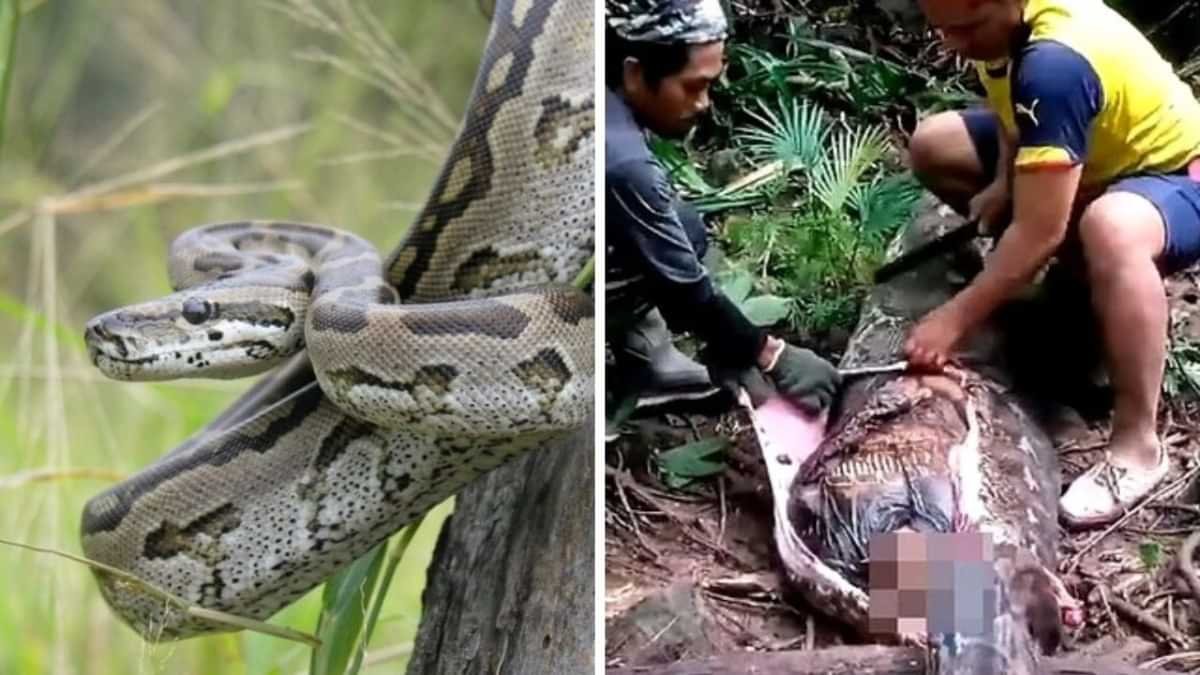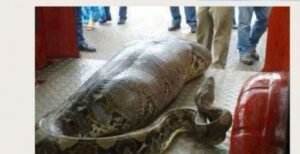Python on Indonesia Sulawesi Island: A devastating snake encounter has shocked communities across Indonesia’s Sulawesi Island. Local authorities discovered the remains of a 63-year-old farmer inside a massive python measuring 26 feet in length. The incident has highlighted the ongoing risks faced by rural communities living near dangerous wildlife.
The farmer, identified as Akbar Salubiro, had been missing for several days before search teams made the grim discovery. His family became concerned when he failed to return home from his daily work in the palm oil plantation. Search efforts intensified as residents joined authorities in combing through dense vegetation and remote areas.
Community Response and Search Efforts
When Akbar didn’t return from his usual farming routine, his worried family immediately alerted local authorities. The tight-knit community rallied together, organizing search parties that scoured the dense jungle terrain. Their worst fears were confirmed when they discovered the enormous python with an unusually distended belly near the plantation area.
Residents used traditional methods to carefully examine the snake’s condition. The python appeared sluggish and unable to move normally due to its recent large meal. Community members worked together to restrain the massive reptile before making the heartbreaking discovery inside.
Python Behavior and Habitat
Reticulated pythons are known for their impressive size and powerful constriction abilities. These snakes typically inhabit tropical rainforests and can grow to extraordinary lengths exceeding 20 feet. Their hunting strategy involves ambushing prey, wrapping around victims, and slowly constricting until breathing becomes impossible.
The species commonly found in Indonesian forests can live for decades and reach enormous sizes. Their diet usually consists of smaller mammals, birds, and occasionally larger prey when opportunities arise. Unfortunately, human encounters with these massive predators have become increasingly common in rural areas.
Rural Indonesia’s Wildlife Challenges
Indonesia’s rural communities face unique challenges when living alongside dangerous wildlife. Palm oil plantations often encroach upon natural habitats, creating more frequent encounters between humans and large predators. Farmers working in remote areas remain particularly vulnerable to these unpredictable situations.
The country’s dense tropical forests provide ideal conditions for large snake species to thrive. Climate change and habitat destruction have forced many animals to venture closer to human settlements in search of food and shelter. These environmental factors contribute to rising conflict between wildlife and local communities.
Safety Measures for Rural Workers
Agricultural workers in snake-prone areas should implement several safety protocols during their daily routines. Working in groups rather than alone significantly reduces risks when entering dense vegetation or remote locations. Carrying noise-making devices can help alert snakes to human presence, allowing them time to retreat.
Key safety recommendations include:
- Never work alone in dense forest areas
- Carry communication devices for emergency situations
- Wear protective boots and thick clothing
- Maintain awareness of surroundings at all times
- Report unusual snake activity to local authorities
Government Response and Wildlife Management
Indonesian authorities have increased patrols in areas where human-wildlife conflicts occur most frequently. Local governments are working to educate communities about snake behaviour and appropriate response measures. These efforts aim to reduce future tragedies while preserving important wildlife populations.
Conservation experts emphasize the importance of maintaining natural habitats to prevent dangerous encounters. When animals have adequate space and food sources, they typically avoid human contact. Proper land management practices can significantly reduce risks for both wildlife and local communities.
Community Healing and Moving Forward
The tragic loss of Akbar Salubiro has deeply affected his family and the broader community. Local religious leaders have provided support during this difficult time, helping residents process their grief and trauma. The incident serves as a sobering reminder of the dangers faced by rural workers throughout Indonesia.
Community members have organized support networks to assist Akbar’s family during their time of mourning. These grassroots efforts demonstrate the strong bonds that exist within rural Indonesian communities. Together, they continue working to prevent similar tragedies from occurring in the future.
Understanding Python Encounters
Wildlife experts stress that python attacks on humans remain relatively rare despite their dramatic nature. These incidents typically occur when people accidentally disturb resting snakes or enter their territory unexpectedly. Understanding snake behavior patterns can help communities develop better prevention strategies.
The massive size of this particular python indicates it was likely an older, well-established individual. Such large snakes require substantial food sources and extended periods between meals. Their slow digestive process means they remain vulnerable for extended periods after consuming large prey.
Conclusion
This tragic incident on Indonesia’s Sulawesi Island highlights the ongoing challenges faced by rural communities living alongside dangerous wildlife. While python attacks remain uncommon, the devastating impact on families and communities cannot be understated. Through increased awareness, improved safety measures, and continued education efforts, similar tragedies may be prevented in the future.
The story of Akbar Salubiro serves as a reminder of the delicate balance between human activity and wildlife preservation. As communities continue to adapt to changing environmental conditions, finding sustainable solutions that protect both people and animals remains a critical priority for Indonesian authorities and conservation organizations worldwide.








Be First to Comment